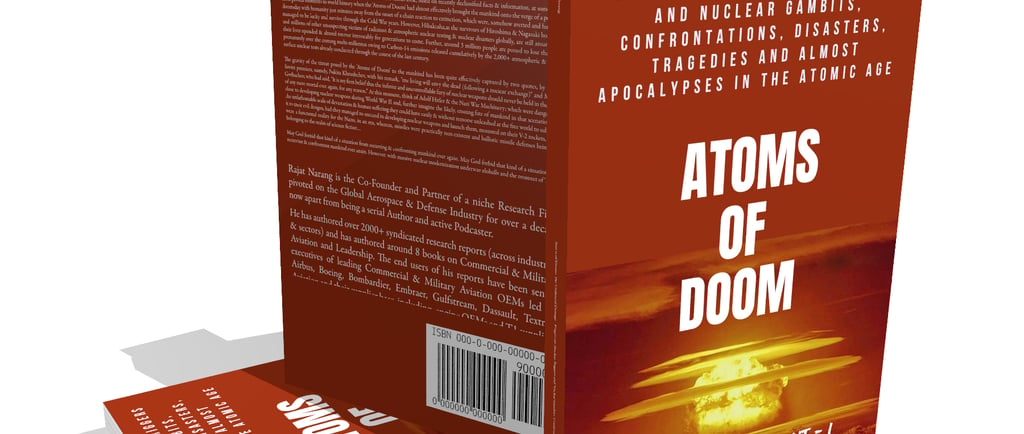Tsar Bomba: The Soviet Planet Shaker and the World's Biggest Nuclear Detonation Ever...
Detonated on October 30, 1961; Tsar Bomba was and still is the world's biggest nuclear detonation with an overall explosive yield of 58 megatons which was more than 3,000 times the output of the Little Boy bomb dropped on Hiroshima. The blast wave generated by Tsar Bomba encircled the planet almost thrice with the first encirclement taking almost 36 hours. Further, the shock wave from the detonation created a seismic wave within the Earth's crust which, too, encircled the planet almost 3 times. The light flash which followed the detonation could have been seen from a distance of almost 620 miles/1000 km away and window panes were found to be broken as far away as 780 km from Ground Zero.


The relentless nuclear arms race, which formed the bedrock the Cold War between the U.S. and the U.S.S.R. for decades, had transitioned from nuclear to the thermonuclear realm after the development of hydrogen bombs by both sides in the early 1950s. In the relentless quest for nuclear one-upmanship; on October 30, 1961, Soviet Union detonated the world’s largest, man-made thermonuclear explosion ever, in form of the Tsar Bomba (also referred to as AN-602 and Big Ivan or simply Ivan while the CIA designated it as JOE-111). Detonated on the desolate island of Novaya Zemlya, located in the Arctic Circle, it produced a mammoth blast yield of 50 megatons (as recorded by the Soviets while the U.S. recorded it at 58 megatons), almost more than 3,000 times that of the ‘Little Boy’ bomb dropped on Hiroshima.
More importantly, the Soviets subsequently said that it had only been tested at half its original design capacity of 100 megatons as the bomb was to be a 3-stage fission-fusion-fission device from which the last fission stage had been omitted to limit the radioactive fallout. The device derived 97.5% of its blast yield from the fusion stage and clearly eclipsed the largest U.S. thermonuclear device ever tested, Castle Bravo, detonated in 1954, which had produced a blast yield of 15 megatons and had led to the development of the Mk-17 warhead.
The Tsar Bomba was a planet shaker and its devastating impact could be gauged from the fact that after being dropped from a height of 40,000 ft. (via a huge parachute to provide the pilots enough time to escape the resulting shock wave) and detonated at a height of around 13,000 ft., an uninhabited village located almost 34 miles/55 km from the Ground Zero was totally flattened while buildings almost 100 miles/160 km away were reported to have been damaged by the shockwave created by the blast. The blast wave generated by Tsar Bomba encircled the planet almost thrice with the first encirclement taking almost 36 hours. Further, the shock wave from the detonation created a seismic wave within the Earth's crust which, too, encircled the planet almost 3 times.
The light flash which followed the detonation could have been seen from a distance of almost 620 miles/1000 km away and broke window panes as far away as 780 km. Further, the shock wave from the detonation of Tsar Bomba caught up and actually knocked the Tu-95V Bear bomber, which had dropped it, out of the sky, thereby, causing it to plummet by around 3,300 ft. at a distance of almost 100 km from the original drop point before the pilot could regain control of the aircraft. Another accompanying bomber, Tu-16, was at a distance of almost 200 km from the drop point and it, too, was impacted by the shock wave. Further, Tsar Bomba alone accounted for almost 10+% of the cumulative explosive yield of 530 megatons, as well as the accompanying radioactive fallout, generated by all the nuclear devices detonated atmospherically by the nuclear powers between 1951 and 1992.
The above is an excerpt from the forthcoming book: Atoms of Doom: Seconds to Midnight - I releasing on August 06, 2024. The book is available for pre-order on Amazon at:- https://www.amazon.com/Atoms-Doom-Confrontations-Disasters-Apocalypses-ebook/dp/B0D8WVH38M


